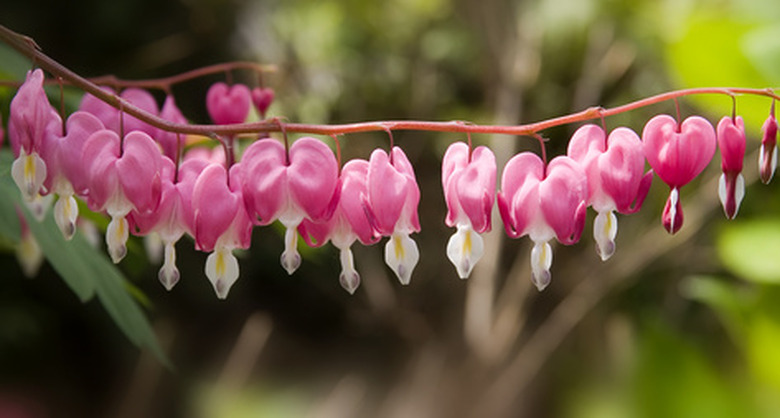Flowers That Hang Upside Down
Flowers decorate any landscape and indoor space, no matter which direction they point. Certain species, rather than growing upward, have blooms that hang downward, giving them a more graceful and fragile appearance that appeals to many growers. Look for plants that have bell-shaped and tubular flowers and cultivate them in places such as hanging baskets and borders, where they'll be most visible.
Bleeding Heart
Bleeding heart, or Dicentra, features mounded foliage. The heart-shaped flowers with white-centered blossoms hang from arching stems. Bleeding heart blooms in shades of pink, red, yellow and white and appear in the spring, making them popular Mother's Day gifts. These perennials are hardy in U.S. Department of Agriculture zones 3 through 9 and grow from 6 inches to 2 feet tall, depending on the variety, and they are deer resistant. Cultivate them in the spring or fall in cool, moist, shady areas, like those where ferns grow. Loosen the garden soil to 15 inches deep and mix in a 2- to 4-inch compost layer. Apply a thin compost layer every spring and mulch around the plant's base to help retain moisture. Prune the branches back to 1 or 2 inches above the soil line after the first killing fall frost.
- Flowers decorate any landscape and indoor space, no matter which direction they point.
- Certain species, rather than growing upward, have blooms that hang downward, giving them a more graceful and fragile appearance that appeals to many growers.
Lily of the Valley
Lily of the valley features delicate, tiny, white bell-shaped flowers that exude a strong but pleasing fragrance. They are often included in wedding boquets. The plant blooms in the spring, grows upward from 6 to 12 inches tall and spreads up to 1 foot by rhizomes. Cultivate it in moderately moist, well-drained soil and in a shady spot where it can grow as a ground cover. Before planting, soak the bulb-like roots in lukewarm water for two to three hours and snip off 1 inch of the root ends.
Angel's Trumpet
Also known as Daturas and Brugmansias, Angel's trumpet is a night-blooming plant featuring large, funnel-shaped blooms in orange and cream hues that remain open until the sunlight shines on them. Their fragrance is powerful and sweet, but they are extremely toxic to people and pets. These South American natives are members of the same family that includes petunias and tomatoes. They thrive best in damp places with warm days and cool nights, and are perennials only in USDA zone 9 and higher. Keep these plants watered, and fertilize them every two or three weeks with a 17-17-17 concentration for potted plants and 15-15-10 for plants grown outside. Keep potted plants pruned to a decent size for indoor spaces.
- Lily of the valley features delicate, tiny, white bell-shaped flowers that exude a strong but pleasing fragrance.
- Keep these plants watered, and fertilize them every two or three weeks with a 17-17-17 concentration for potted plants and 15-15-10 for plants grown outside.
Fuschia
Fuschia plants are shrubs that greenhouses often sell in hanging baskets. They are cold-hardy to 39 degrees F, but they can be finicky when it comes to their growing requirements. The plants bloom from June to September and feature deep pink flowers that include both male and female organs and that are pollinated by bees and birds. Grow fuschias in well-drained, fertile, moist soil and in partial shade or full sun.
